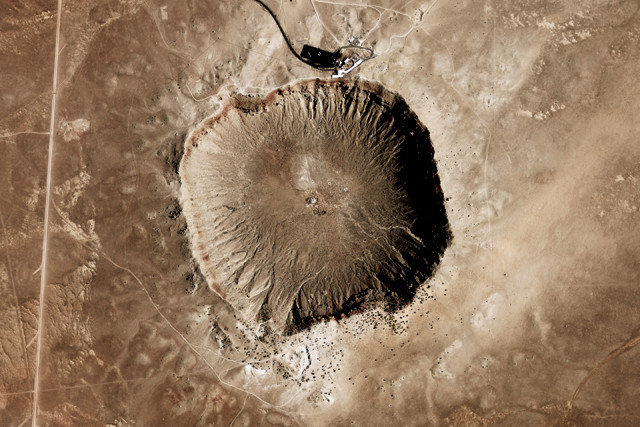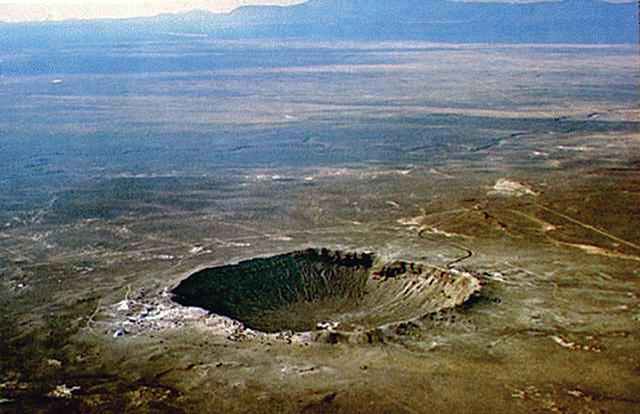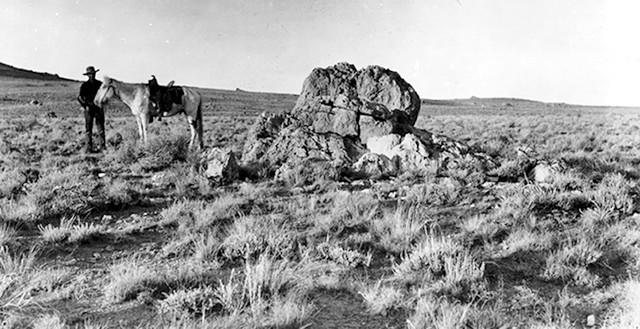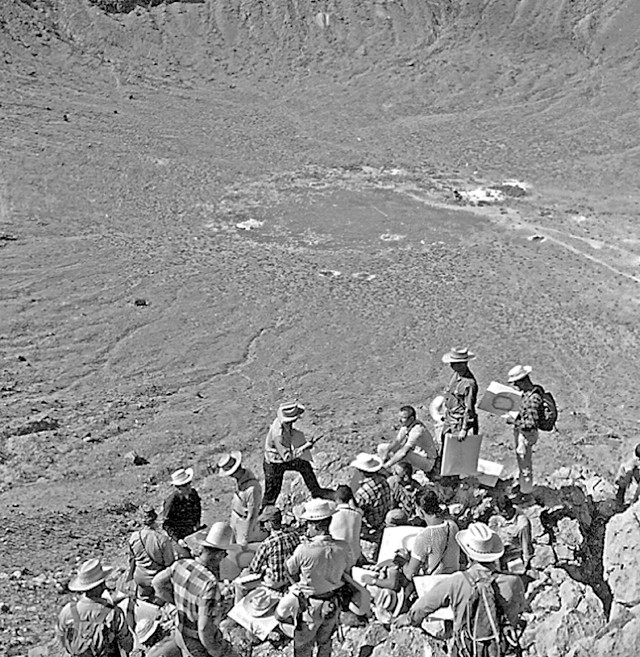
by Julia Rosen Monday, June 8, 2015

Meteor Crater near Flagstaff, Ariz. Credit: NASA Earth Observatory.
In 1923, Daniel Moreau Barringer stood on the edge of a vast bowl-shaped depression in the Arizona desert, watching a drill rig bore into the floor of the crater. Barringer had spent more than two decades exploring the massive hole, which lies on the Colorado Plateau 65 kilometers east of Flagstaff, Ariz. And although he had sunk dozens of drill holes, collected scores of samples, and carefully mapped the piles of talus that draped its concave walls, Barringer still hadn’t found what he was looking for, and he was getting nervous.
The lawyer-turned-geologist had staked his fortune on the strength of two convictions. The first was that a massive meteorite impact had excavated the void before him. The second was that this meteorite had lodged beneath the crater floor, and that the iron mass could be excavated and sold. Based on these beliefs, Barringer had taken out a mining claim on the land 20 years earlier and established the Standard Iron Company, which had yet to see its first ton of ore.
But Barringer also had another problem: His ideas about the crater faced fierce opposition from many prominent scientists. The origin of the hole had become the subject of a long and bitter debate between Barringer and Grove Karl Gilbert, a towering figure at the U.S. Geological Survey (USGS). The dispute would only be resolved after both men had died, when scientists reported the discovery of the shock-mineral coesite in the crater on July 22, 1960.

Meteor Crater, which is roughly 50,000 years old, was the first impact structure recognized on Earth. Credit: David J. Roddy, USGS.
Barringer first heard about the cratered dome called Coon Mountain in 1902 during a chance encounter with a Forest Service agent named Samuel Holsinger. Holsinger told him of a giant hole in the ground littered with iron fragments believed to be meteorites, some weighing up to several hundred kilograms. Locals said an even larger meteorite had blasted out the crater.
Although Barringer was skeptical — at this time, an impact structure had never been documented on Earth — he couldn’t resist the alluring notion that tons of valuable metal lay hidden in the desert. Less than a year later, Barringer enlisted a partner, an amateur scientist named Benjamin Tilghman, and secured the mining rights to the land without ever having seen it. He even began building the bunkhouses and railroad tracks he believed the enterprise would soon demand.
Barringer finally visited the crater in 1904 and, together with Tilghman and Holsinger, whom he had recruited to the cause, began a geologic investigation. They found that the locals had been right; everything about the hole suggested it had formed from a cataclysmic collision.
They noted the upturned rock layers that formed the crater’s rim and the inverted stratigraphy of the ejected debris, both signs of the outward blast of the explosion. They also documented deposits of silica flour so fine that it produced “no grit between the teeth,” which they interpreted as pulverized sandstone. Perhaps most convincingly of all, they noticed the uniform distribution of iron meteorites around the rim and the interbedding of meteorites and debris, which suggested the meteorites were related to — and had likely caused — the explosion.
Barringer presented these results before the Academy of Natural Sciences of Philadelphia in 1905, arguing that they constituted ample proof of the impact hypothesis. In fact, he went even further, saying that he could not imagine how “any experienced geologist” who had visited the crater could support an alternate explanation. In the 1890s, though, Gilbert, one of the most revered geologists of the day, had studied the crater and concluded that it owed its existence not to a meteorite impact, but to a violent subterranean steam explosion.

A photo of Meteor Crater taken in 1891 by Grove Gilbert, who believed it was a maar crater, created by a steam explosion triggered by the interaction of groundwater and magma. Credit: G.K. Gilbert, USGS.
Although both men were charismatic and well liked, Barringer and Gilbert had different approaches to science. Where Barringer was enthusiastic, Gilbert was methodical. Where Barringer prized conviction, Gilbert favored caution. Barringer’s tastes — which included big-game hunting, whiskey drinking and cigar smoking — contrasted starkly with Gilbert’s gentle manner and scholarly pursuits. Indeed, some have suggested that the personal enmity between these pioneering geologists likely contributed to their long standoff, which had begun innocently enough.
Gilbert learned of Coon Mountain at a meeting of the American Association for the Advancement of Science in 1891, when the mineralogist Arthur Foote gave a talk about a collection of diamond-bearing meteorites found at the site. Although Foote had traveled to Arizona and had carefully analyzed the samples, he did not draw any causal connection between the hunks of extraterrestrial iron scattered around the crater and the gaping hole itself.
But Foote’s descriptions captivated Gilbert, who soon set out to survey the crater himself. The first time he saw the feature — 180 meters deep and roughly 1.2 kilometers across — he too suspected a meteor impact, like those seen on the surface of the moon. But Gilbert was dedicated to the principle of rational investigation, so he developed multiple working hypotheses, including the idea that the crater could have been created by a steam explosion resulting from the subsurface interaction of magma and groundwater.
He then endeavored to determine which explanation was right. He came up with two tests of the meteorite hypothesis: a magnetic survey that would betray the presence of a hidden mass of metal, and a detailed topographic analysis to determine whether the volume of ejected debris equaled or exceeded the volume of the void (he reasoned that a buried meteorite would have displaced even more material). Unfortunately, both of these analyses relied on the same untested assumption: that the bulk of the meteorite still existed intact.
After several weeks of work, Gilbert returned home to pore over his notes. Finally, in 1895, before the Geological Society of Washington, he presented his findings: Lacking any evidence for a buried meteor, he concluded the crater must have formed by a steam explosion similar to what happened at Krakatoa 12 years earlier. The abundant iron meteorites, he said, had fallen there by coincidence.
Since no one had ever found an impact crater on Earth before, the scientific community had no reason to question his results. Instead, his peers accepted the steam-explosion hypothesis, and refused to abandon it, even as contrary evidence compiled by Barringer and others mounted against it.
Gilbert never publicly recanted, or even acknowledged Barringer’s position. Meanwhile, Barringer’s habit of smugly insulting Gilbert in most of his papers probably didn’t help the pair’s relationship. Even after Gilbert’s death in 1918, USGS geologists continued to maintain that the hole in the hill then called Crater Mountain had been formed by steam.

Gene Shoemaker, who settled the decades-long debate over Meteor Crater's origins, lectures a group of Apollo astronauts on the crater rim in May 1967. Credit: USGS.
A geologist from the same agency, however, would later solve the mystery once and for all. His name was Eugene Shoemaker, and in the late 1950s, he was finishing his doctorate at Princeton University, where he studied the crater for his thesis.
Like Gilbert and Barringer before him, Shoemaker conducted careful geologic investigations of the site, but he had one important advantage over the others: He could now compare the crater to those formed by shallow underground nuclear weapons tests carried out in Nevada during the Cold War. In particular, he made detailed comparisons between the Arizona crater and the Teapot ESS crater, a slightly smaller feature formed in 1955 by the explosion of a 1.2-kiloton bomb.
Shoemaker noted striking similarities between the sites, including the inverted stratigraphy of the ejected debris, the aprons of fallout around the craters’ rims, and the presence of shattered and shocked bedrock within the craters themselves. These parallels suggested that the Arizona crater was indeed created by the shockwave produced by a projectile slamming into Earth’s surface or exploding underground.
The final piece of evidence came when Shoemaker sent samples of shocked sandstone to USGS mineralogist Edward Chao. Chao recognized that these samples contained the mineral coesite, a high-pressure relative of quartz that had been synthesized in the lab by Loring Coes in 1953, but had never before been found in nature.
When Chao, Shoemaker and Beth Madsen, also of USGS, published their discovery in Science in July 1960, they closed the debate over the crater’s origin and opened up the field of astrogeology, which Shoemaker pioneered and led until his retirement from USGS in 1993.
Unfortunately, for Barringer, who died in 1929, vindication of the impact hypothesis came too late. This was also true of many other scientific revelations about the crater, including its probable age (closer to 50,000 years old, not 2,000 to 3,000 years old, as Barringer suspected), and the meteorite’s probable speed at the time of impact (between 12 and 16 kilometers per second). But one important realization did come to light during Barringer’s life, and it may have played a role in his death.
By 1928, Barringer’s mining prospects seemed dim. Tilghman had abandoned the crater years before, and Standard Iron struggled to attract investors to fund the ongoing hunt for the buried meteorite. So Barringer contacted University of Chicago astronomer Forest Moulton, an expert on impacts who, together with Thomas Chamberlin in 1905, had developed the theory that planets form by the collision and accumulation of smaller planetesimals. Barringer asked Moulton’s opinion of the size and fate of his meteorite.
Moulton made some calculations that suggested the meteorite was probably much smaller than Barringer had assumed — it almost certainly weighed less than 500,000 tons, a mere fraction of Barringer’s optimistic 10-million-ton estimate. But more importantly, Moulton showed that the bulk of the meteorite would have vaporized on impact. This meant Barringer’s long quest had been in vain; there was no buried iron to be found.
By this time, Barringer and his backers had spent more than $600,000 in search of the meteorite — close to what he thought the mass of buried iron would be worth. One week after receiving Moulton’s final communication, Barringer died of a heart attack.
Today, Barringer’s family still retains the rights to the land under his 199-year lease, and the hole that consumed his life now bears the name of his hard-won hypothesis: Meteor Crater. However, another name is preferred among astronomers, for whom the crater is a terrestrial monument to the cosmic phenomena they study, one that spawned an entirely new field of science.
They call it Barringer Crater.
© 2008-2021. All rights reserved. Any copying, redistribution or retransmission of any of the contents of this service without the expressed written permission of the American Geosciences Institute is expressly prohibited. Click here for all copyright requests.